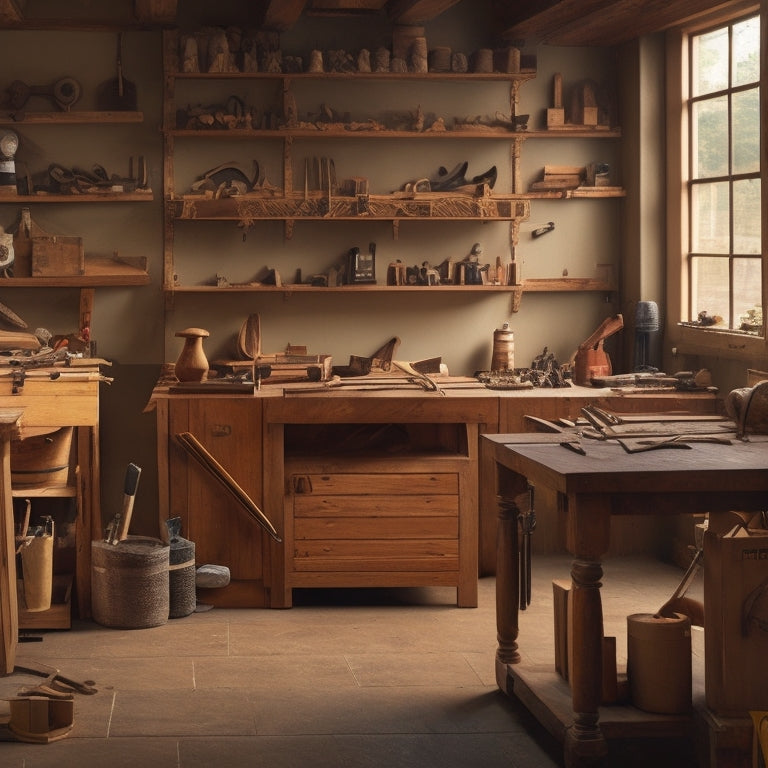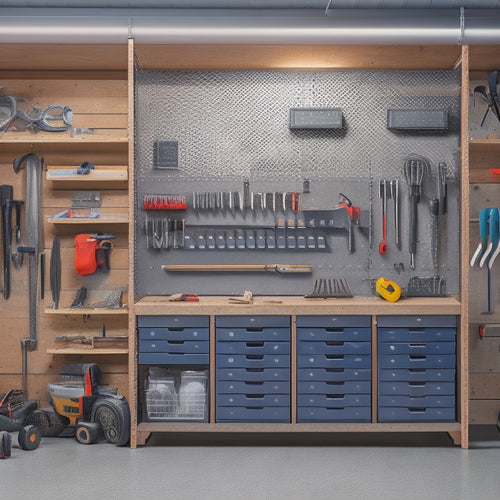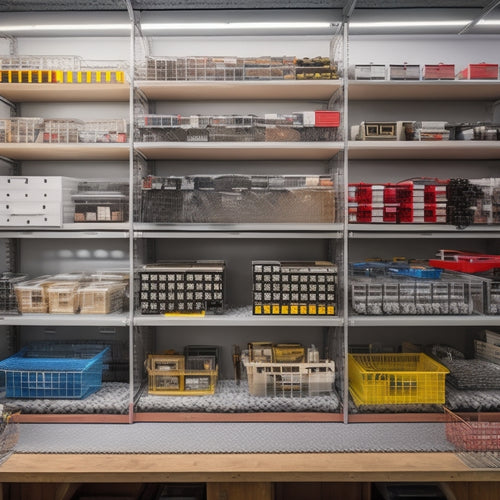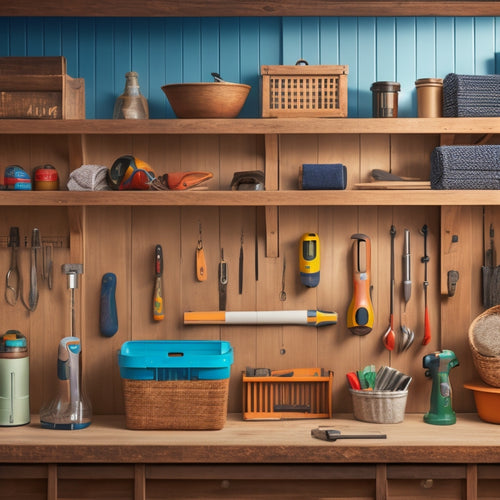
Master Your Woodworking Projects With 5 Essential Tips
Share
You're on the verge of taking your woodworking skills to the next level by adopting five essential habits. Start by planning your project meticulously, considering every detail from wood type to tool requirements. Next, optimize your workshop for maximum efficiency and safety. Invest in high-quality tools and maintain them regularly for professional-looking results. Measure twice, cut once to avoid costly errors, and stay focused by minimizing distractions and setting realistic goals. By mastering these habits, you'll be on your way to creating stunning woodworking projects that exceed your expectations - and there's more to explore to help you get there.
Key Takeaways
• Plan your project carefully, considering factors like wood type, durability, and grain pattern to ensure success.
• Organize your workshop efficiently to minimize accidents, maximize productivity, and easily access tools and materials.
• Invest in high-quality tools, maintain them regularly, and prioritize safety to achieve professional-looking results.
• Adopt the "measure twice, cut once" rule to avoid costly errors, ensure accuracy, and maintain precision in your work.
• Stay focused, avoid distractions, and break down complex tasks into manageable chunks to produce high-quality woodworking results.
Plan Your Project Carefully
Before delving into your woodworking project, take the time to carefully plan out every detail, from the type of wood you'll use to the tools you'll need, to avoid costly mistakes and secure a successful outcome.
Material selection is important, so consider factors like durability, grain pattern, and color to make sure the wood you choose fits your project's requirements. You'll also want to think about the tools and equipment you'll need, making sure you have everything necessary to complete the job.
Effective time management is also essential to a project's success. Break down your project into smaller, manageable tasks, and create a schedule to help you stay on track. This will help you avoid procrastination and guarantee that each step is completed efficiently.
Organize Your Workshop Efficiently
How efficiently can you work in a cluttered, disorganized workshop, where tools and materials are scattered all over the place, making it difficult to focus on the task at hand? Probably not very efficiently. A well-organized workshop is essential to completing woodworking projects successfully.
Start by optimizing your tool storage. Designate a specific spot for each tool, and use storage bins, hooks, and shelves to keep them within easy reach. This will save you time and reduce frustration.
Next, focus on your workbench layout. Consider the workflow of your projects and arrange your workbench accordingly. Position your most frequently used tools and materials in convenient locations to minimize walking distances and maximize productivity. A well-planned workbench layout will also help you avoid accidents and injuries.
Choose the Right Tools Wisely
With a well-organized workshop in place, you can now focus on selecting the right tools to guarantee your woodworking projects turn out exactly as envisioned. Having the right tools is essential to achieving professional-looking results and safeguarding your safety while working on projects.
Here are some essential tips to keep in mind when choosing your tools:
-
Invest in high-quality tools: While it may be tempting to opt for more affordable alternatives, high-quality tools will last longer and perform better, saving you time and frustration in the long run.
-
Prioritize tool safety: Make sure that your tools are in good working condition and properly maintained to avoid accidents. Regularly inspect your tools for signs of wear and tear, and take steps to address any issues promptly.
-
Develop a tool maintenance routine: Set aside time each week to clean, lubricate, and store your tools properly. This will help extend their lifespan and keep them in good working order.
Measure Twice, Cut Once Always
You'll avoid costly errors and wasted materials by adopting the mantra 'measure twice, cut once,' an essential habit that separates experienced woodworkers from beginners. This simple yet vital principle will save you time, money, and frustration in the long run.
By taking the time to double-check your measurements, you'll make sure that your cuts are accurate and your project turns out as planned. Practice precision by using a combination of measuring tools, such as tape measures, calipers, and squares. Take your time, and don't rush through the measuring process.
It's better to take a few extra minutes to confirm your measurements than to risk making a mistake that can't be undone. Stay patient, and embrace the challenges that come with woodworking. Remember, it's not about being perfect; it's about being accurate.
Stay Focused, Avoid Distractions
As you settle into your woodworking routine, maintaining focus becomes key to producing high-quality results, and minimizing distractions is vital to achieving that focus. You can't afford to let your mind wander or get sidetracked by non-essential tasks.
To stay on track, prioritize time management by setting realistic goals and deadlines for each project phase. This will help you stay committed to the task at hand and avoid procrastination.
Additionally, incorporating mindfulness practice into your woodworking routine can be incredibly advantageous. Take regular breaks to stretch, breathe deeply, and refocus your attention. This will help you stay present and avoid mental fatigue.
Here are some strategies to help you stay focused and avoid distractions:
-
Designate a specific workspace that's quiet, organized, and free from clutter
-
Turn off notifications and electronic devices while working
-
Break down complex tasks into smaller, manageable chunks to maintain momentum
Frequently Asked Questions
How Do I Deal With Wood Warping or Splitting During a Project?
You'll avoid wood warping and splitting by ensuring proper wood moisture levels, around 6-8%, and using techniques like gradual drying, acclimation, and careful joint design to prevent warping, ensuring your project turns out smooth and stable.
Can I Use Reclaimed or Recycled Wood for My Woodworking Projects?
You'll be amazed to know that 1 billion pounds of wood waste end up in landfills annually! Using reclaimed or recycled wood for your projects is a great way to reduce waste, embracing upcycled materials and sustainability, while giving vintage lumber a new life with minimal environmental impact.
What Safety Precautions Should I Take When Working With Power Tools?
You must prioritize safety when working with power tools, wearing essential safety gear like goggles and gloves, and taking precautions like proper tool maintenance and techniques to minimize risks and guarantee a secure workspace.
How Do I Achieve a Smooth, Even Finish on My Woodworking Projects?
'You're about to reveal the secret to a showroom shine, like a masterpiece emerging from a dusty attic. To achieve a smooth finish, master sanding techniques, explore staining options, and apply varnish for a glossy finish that wows.'
Can I Use a Woodworking Project Plan Designed for a Different Type of Wood?
You can adapt a woodworking project plan for a different wood type, but guarantee the design accommodates the new material's characteristics; consider project compatibility, material sources, and adjust accordingly to achieve a successful outcome.
Related Posts
-

Building a Wall Tool Storage System
You're about to create a customized wall tool storage system that streamlines your workflow. Start by clearing your w...
-

10 Essential Steps for Small Parts Bin Storage
To optimize your small parts bin storage, start by defining your storage needs and goals, considering factors like av...
-

What Tools Do I Need for a DIY Wall Organizer
You'll need a variety of tools to complete a DIY wall organizer project. Essential measuring tools include a tape mea...


